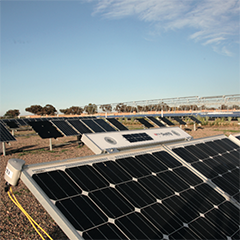Kipp & Zonen continue with their quest to improve the DustIQ, which can now be locally calibrated for the exact dust composition on site. This means the PV panels can be monitored 24/7 and cleaned whenever necessary. PES delves deeper to bring you the latest on this affordable and compact, cost saving, optical measuring tool.
The maximum efficiency exhibited by solar cells has been incrementally improved over 150 years of scientific endeavour. But while photovoltaic technology continues to improve, the amount of power we can generate from solar cells is ultimately dictated by environmental factors.
Primarily these are solar irradiance, temperature, and soiling. While the effects of solar irradiance and temperature are well-understood, the detrimental effects of soiling on solar panel performance often go overlooked. However, new technologies are making it easier than ever before to measure the effects of panel soiling on photovoltaic performance.
Advances in increasing solar cell efficiency
The world’s first photovoltaic device was created by Edmond Becquerel at the ripe old age of 19, while conducting experiments in his father’s laboratory.1 Edmond, the son of prolific electro-/bio-chemist Antoine Becquerel, found that a platinum electric I think they mean conductor coated with a thin layer of silver chloride could be coaxed into exhibiting a phenomenon previously unknown to science: When placed in an electrolytic solution with another electrode and illuminated, a current started to flow.2
His experiments were meticulous. Having ruled out thermoelectric effects and even managing to obtain a rough spectral response curve by shadowing the electrode with a series of coloured filters, he correctly deduced the nature of the chemical reaction that occurred at the photosensitive electrode. Becquerel had created a liquid-phase photoelectric cell, the precursor to the familiar (and much more convenient) silicon cell which would go on to become the fastest-growing renewable energy source in the early 21st century.3
Photovoltaic cells have come a long way since Becquerel’s experiment in 1839. In 1876, scientist William Grylls Adams showed that photovoltaic current could be generated without heat transfer or moving parts, laying the foundation for modern photovoltaic cells.4 Over the next 50 or so years, the photovoltaic effect (or ‘Becquerel effect’) was demonstrated in a number of different materials, but efficiency did not budge from around 1% until the 1950’s when the power of silicon was discovered. In 1954, Bell Labs made headlines with the first ‘practical’ silicon solar cell, with an efficiency of 6%.5
The front page of the New York Times the next day proudly proclaimed that the ‘Vast Power of the Sun is Tapped’, these cells heralded the arrival of compact, efficient and commercially viable solar cells.6 Since then, the sustained efforts of generations of scientists and engineers have multiplied the efficiency of solar cells several times. As of December 2014, the world record for photovoltaic efficiency, the ratio of incident solar radiative energy to usable electrical output, stands at an impressive 46%.




























